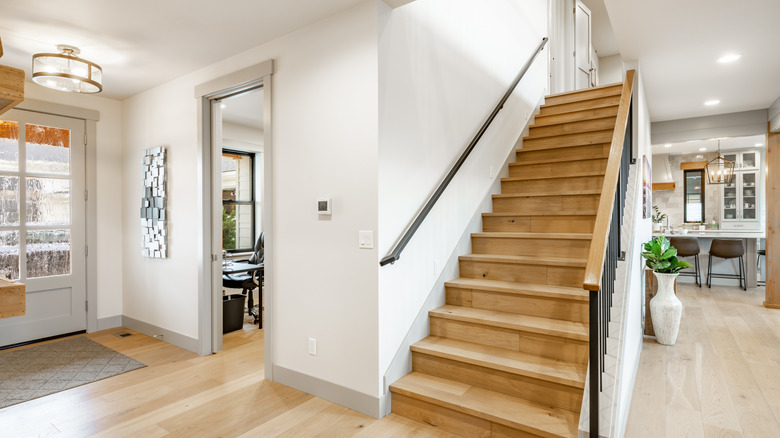Give Your Doorways A Unique Splatter Effect With A Fun & Easy Paint DIY
Solid-colored rooms, especially those painted entirely white or off-white, often feel sterile and uninspiring without the interest of more dynamic color palettes. Of course, there are ways to add color to neutral rooms through art, accent walls, and curtains. But there is an area of your room that you may be overlooking when it comes to adding color: the doorway. Paint allows you to add color without sacrificing any doorway space. Giving your doorway and door trim a coat of brightly colored paint is one idea, but there's a fun way to get some of the color to spill out onto the walls of your room. This doorway splatter effect involves painting your doorway and then creating and filling in a fun outline on the surrounding walls to look as if the paint spilled or splattered off of the doorway.
This is a really simple way to add color and interest to your walls and doorway when you want to create a fun, unique look. It's perfect for a child's bedroom, craft room, or other areas that inspire creativity, but you can also use it throughout your home. The great thing about this DIY is that there is no single way it needs to be done. If the mood of the room is light and fun, you can paint a door border that's lively and exciting. If your tastes are more sophisticated, there are plenty of ways to use this idea to add color without making the room look unserious.
How to DIY a colorful doorway
Start this project by choosing the design you want to make around your doorway. Freehand the design for a more natural look, or use stencils for sharper edges. For example, you can make a freehand squiggly or scalloped pattern around the door, or use wall stencils to make flowers or geometric designs. There are no limits to what type of shape you make and how far it reaches beyond the doorway onto the wall. When you've decided on the design and the color, it's time to paint.
Paint the doorway trim, followed by anywhere from a few inches to a foot or more of the surrounding wall. If you are going with a fun wavy border, when you've finished the door frame, freehand the outline of your door border to give yourself a guide. Then, fill in the outline with paint, and apply a second coat, if necessary. For a jagged or angular border, you can use painter's tape to help you create the solid lines.
To implement this DIY in a room that begs for something more refined, you can use painter's tape to keep the walls clean while you paint the doorway. Then, remove the tape and use wall stencils around the doorway's border. You can use the same color for the entire border, alternate colors, or use a different color entirely. Not every interior doorway contains a door, but if yours does, it may also be a good idea to paint it. You could paint the door to match the trim and add stencil patterns with inverse colors. Painting the door a matching bright color could add interest to the room, as well.
Choosing the right paint for your doorway
Picking the right paint helps this DIY last. Enamel paint is usually used for doorway trim to make sure it can hold up well. For this DIY, you can use a traditional semi or high-gloss paint for the doorway and then switch to a different type to match the one already covering your walls. You can also switch things up and use a matte or eggshell finish for both or a high-gloss finish for both. High-gloss paint is both easier to clean (great for wiping fingerprints from doorways) and reflective, so it draws the eye better than a matte finish. The type of paint you choose ultimately comes down to personal preference and what will hold up well on the doorway.
It's often a good idea to choose a color that complements other elements in the room. For example, if you are painting your bedroom doorway and your comforter and lamp are a light shade of blue, pale orange will complement those blue tones. Since green complements pink, you might choose green for your new doorway color if your room contains a lot of pink elements. If you're unsure about which colors are complementary, you can refer to the color wheel that many paint brands display on their websites. Of course, there is no need to choose a complementary color. You can match the doorway's paint with the room's decor or even get a little wild and pick something that's a total mismatch. This DIY is all about creativity and what makes you happy.

